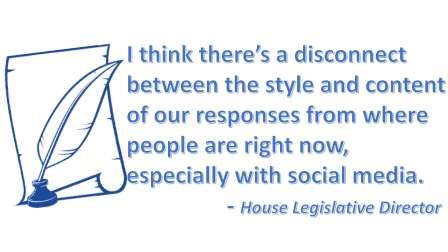Writing Letters (or Email)
The public's expectations of how they interact with elected officials has changed dramatically over the last few decades, but many offices haven't changed their practices to match. Now that everyone has access to many sources on congressional activity (some reliable, some not), people no longer rely on congressional offices to explain bills and provide them with legislative updates. Instead constituents want to hear how the Representative/Senator feels about issues that are important to them.
Another dramatic difference is the rise of issue campaigns generated by advocacy organizations. For most offices, this type of message now accounts for 75%-85% of incoming mail. This begs the question: Do constituents want or expect a full response or are they just making their position known to the Senator/Representative? In looking at a few offices' email open rates (available in most correspondence management systems), it seems that only about half of the recipients open the office's reply. Constituents want to know they've been heard. The key is to write content that assures them they have been.
CMF asked one of the offices that made our recommended changes to their mail system if their Member had noticed the changes. The staffer replied, "Yes, because constituents noticed and told him! They commented that they feel like they know where he stands and have even forwarded messages to their friends." She also indicated that the office's greatest success with the changes was that they were able to keep up with the increased communications in 2017! They produced higher-quality letters in less time, so they responded to many more messages with less staff time involved, even during the peak of early-2017 communications volumes.
Why You Should Do This

Many congressional offices are writing letters like it's 1979, but that's not what constituents expect in the current 140-character-limit world. Offices should focus more on connecting with constituents in short messages and less on trying to persuade them with legislative research or impress them with congressional letterhead and Member signatures.
What We Learned
- Focus on connecting, not persuading. Instead of giving lengthy policy explanations or legislative status updates, write shorter responses that focus on your Representative's/Senator's views and actions. Link to existing content such as YouTube videos of him or her speaking; weekly explanation of votes on major bills on the webpage; or issue statements on Facebook. This will add a more personal touch to your replies and help constituents understand why your boss is voting a certain way.
- Eliminate pro/con letters. Many offices write two separate letters for each issue: one for those who oppose and one for those who support his/her view. Doing so creates additional work for staff and risks sending someone the wrong letter. If your boss has taken a position, simply state it and his/her reasoning in a matter-of-fact tone. No need to persuade or be defensive. If your boss has not taken a position, simply connect to the issue and constituents in a different way.
- Create higher value, but fewer, responses. Instead of creating a separate message for each individual campaign, group them together by broad policy areas (ex: changes to the tax code, protecting natural resources, regulatory reform). Then craft a high quality response on that topic with lots of links describing the Representative's/Senator's position and action taken to support it.
- Involve the communications staff in constituent correspondence. In most offices, legislative staff oversee constituent correspondence and communications staff handle outreach. However, by coordinating, the office can develop common messages and talking points that, once approved can be repurposed for a variety of uses: responses to constituents, phone campaigns, Facebook, the website, and so on. This ensures consistency and reduces drafting and approval time. It can also help ensure responses to constituents are high-value and not too detailed. A few offices have even changed their organizational chart to make the Communications Director—instead of the Legislative Director—oversee all aspects of constituent correspondence.


